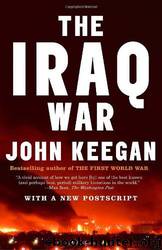The Iraq War by John Keegan

Author:John Keegan
Language: eng
Format: mobi, epub
ISBN: 9781407064383
Publisher: Random House
Published: 0101-01-01T00:00:00+00:00
6
The American War
History repeats itself, though no two historians agree quite how. Those who reported the First Gulf War of 1990–91 had an almost eerie impression of events replicating themselves between Iraq and its enemies twelve years later but, once the campaign began to unfold, it was the differences rather than the similarities which commanded attention and demanded explanation. In February 1991 a very large and high-quality Western army confronted an equally large but low-quality Iraqi army and, following six weeks of intense aerial attack, destroyed its military capability in four days of fighting. In March 2003 a much smaller but even higher quality Western army confronted an Iraqi army degraded and ennervated by its earlier defeat and by twelve years of isolation from its foreign sources of supply and, during three weeks of high-speed advance over long distances, brought about not merely its disintegration but its apparent evaporation from the field of battle. By the beginning of April the evidence of defeat strewed the Iraqi landscape, discarded small arms, shot-riddled military vehicles, burnt-out tanks and the pathetic, ragged bodies of Iraqi dead; yet not only had Saddam’s army disappeared from view. The signs lacked that it had ever been there. There were no columns of surrendering prisoners, no senior officers offering their capitulation. The war was over but where was the defeated enemy? For all the millions of rounds of ammunition expended, for all the thousands of tons of high explosive delivered to targets, it was as if the Iraqi army had not existed in the first place. American and British soldiers could testify to the undoubted experience of combat, often at high intensity; but when the shooting stopped, their enemies had vanished.
Yet the Iraqi army had undoubtedly existed before the shooting began. Coalition intelligence had a clear picture of its order of battle and had drawn up detailed situation maps of its deployment on the ground. The Iraqi forces consisted of three elements. Militarily the most significant was the Republican Guard, founded by President Arif in the early 1960s as his régime’s praetorian guard to protect it against coups and officered and to a considerable extent recruited from Arif’s al-Jumaila tribe, who live in the al-Ramadi region on the Euphrates west of Baghdad. Originally only of brigade size, though with an integral tank regiment, it was progressively expanded under Arif’s successors. Saddam raised it to a strength of six divisions, recruited and officered from men identified for their loyalty to himself personally and to the Ba’ath party. At the outbreak of war in 1991 it consisted of the Adnan Mechanized Division, the Baghdad Infantry Division, the Abed Infantry Division, the Medina Armoured Division, the Nebuchadnezzar Infantry Division and the Hammurabi Mechanized Division. Saddam also raised a Special Republican Guard of three brigades as an inner security force, commanded by his son Qusay, but it was not organized for combat. The Republican Guard retained its strength of 60,000 men in 2003, though its equipment, like that of all formations in Iraq, was badly serviced and short of spare parts.
Download
This site does not store any files on its server. We only index and link to content provided by other sites. Please contact the content providers to delete copyright contents if any and email us, we'll remove relevant links or contents immediately.
| Elections & Political Process | Ideologies & Doctrines |
| International & World Politics | Political Science |
| Public Affairs & Policy | Specific Topics |
| United States |
The Secret History by Donna Tartt(18951)
The Social Justice Warrior Handbook by Lisa De Pasquale(12170)
Thirteen Reasons Why by Jay Asher(8848)
This Is How You Lose Her by Junot Diaz(6836)
Weapons of Math Destruction by Cathy O'Neil(6220)
Zero to One by Peter Thiel(5736)
Beartown by Fredrik Backman(5682)
The Myth of the Strong Leader by Archie Brown(5461)
The Fire Next Time by James Baldwin(5386)
How Democracies Die by Steven Levitsky & Daniel Ziblatt(5175)
Promise Me, Dad by Joe Biden(5116)
Stone's Rules by Roger Stone(5053)
A Higher Loyalty: Truth, Lies, and Leadership by James Comey(4909)
100 Deadly Skills by Clint Emerson(4882)
Rise and Kill First by Ronen Bergman(4741)
Secrecy World by Jake Bernstein(4703)
The David Icke Guide to the Global Conspiracy (and how to end it) by David Icke(4658)
The Farm by Tom Rob Smith(4468)
The Doomsday Machine by Daniel Ellsberg(4452)
